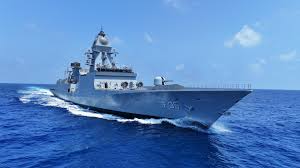Tamal, last foreign-made warship, commissioned; Udaygiri delivered

India has entered a new era of naval self-reliance. On one side, the Navy commissioned INS Tamal, its final foreign-built warship. On the other, it received INS Udaygiri, a modern indigenous stealth frigate.
Together, these milestones reflect India’s firm move towards self-sufficiency in defense production. They also align with the broader national goal under the Atmanirbhar Bharat (Self-Reliant India) campaign.
INS Tamal: A Farewell to Foreign-Made Warships
INS Tamal was constructed in a foreign shipyard through an international defense agreement. Designed for multi-role missions, the ship supports anti-submarine warfare, surveillance, and escort duties. Despite its advanced features, it symbolizes the end of an era.
According to defense officials, India will no longer place warship orders abroad. All future warships will be built in Indian shipyards. This policy shift promotes innovation, creates local jobs, and boosts national pride.
The Navy held a ceremonial commissioning for INS Tamal. Naval chiefs and ministry officials attended the event. They highlighted the importance of reducing foreign dependence and strengthening domestic capabilities.
INS Udaygiri: The Future of Indian Naval Power
On the same day, the Navy took delivery of INS Udaygiri, an indigenous stealth frigate built under Project 17A. The ship was designed and constructed by Mazagon Dock Shipbuilders Limited (MDL) in Mumbai.
INS Udaygiri is named after the Udaygiri mountain range in Andhra Pradesh. It’s the third ship in the Project 17A series, which builds on the success of the earlier Shivalik-class frigates.
What sets Udaygiri apart is its use of stealth design, automation, and homegrown technology. It carries Indian-made BrahMos missiles, air defense systems, radars, and sonar equipment. Over 75% of its components are sourced from Indian firms.
This ship demonstrates how far India’s defense manufacturing sector has come. It also shows that Indian shipbuilders can deliver advanced warships on par with global standards.
Why Self-Reliance Matters
India’s growing focus on local defense production is not just about economics. It is a strategic necessity. In recent years, global supply chain issues and geopolitical uncertainties have exposed the risks of foreign dependence.
Now, the Ministry of Defence is committed to supporting Indian manufacturers. The Navy is leading this push, with over 30 Indian-built ships and submarines commissioned since 2014.
This move also creates more opportunities for Indian technology firms and engineers. By involving local vendors in shipbuilding, India strengthens its industrial base and creates a pipeline for future innovations.
Strategic Importance in the Indo-Pacific
The shift to indigenously built ships comes at a critical time. The Indo-Pacific is becoming a contested region. China continues to expand its naval footprint. India must strengthen its maritime presence to protect its interests.
Ships like INS Udaygiri will play a key role in safeguarding India’s Exclusive Economic Zone (EEZ). They will also support regional patrols and international joint exercises.
India’s ability to build its own warships adds a layer of strategic flexibility. It allows quicker deployment, easier maintenance, and reduced political risk.
Defense Exports on the Horizon
India’s success in indigenous shipbuilding also opens doors for defense exports. The government is now promoting warships, patrol boats, and smaller submarines to friendly nations.
Several countries in Asia, Africa, and Latin America have already expressed interest. India hopes to become not only a buyer but also a seller of quality defense products.
With Project 17A and similar programs, Indian shipbuilders have proven they can meet global standards. This could turn India into a hub for affordable, reliable warships.
Overcoming Past Challenges
Critics have often pointed out India’s delays and cost overruns in defense projects. However, INS Udaygiri and its sister ships show significant progress.
By adopting modular construction and digital ship design, Indian shipyards have reduced build time. They have also increased efficiency and quality control.
Furthermore, collaboration between the Navy and private firms has helped solve long-standing problems. These include delays in weapon integration, electronics, and propulsion systems.
Looking Ahead: A Stronger Indian Navy
India has big plans for its Navy. The goal is to expand the fleet to 200 ships by 2030. Most of these will be built in India. Upcoming projects include:
- Project 17B stealth frigates
- Project 75I submarines
- Indigenous Aircraft Carrier-2 (IAC-2)
Each of these projects will boost India’s defense ecosystem. They will also train thousands of skilled workers and create a self-sustaining naval industry.
Conclusion: A Dual Message of Transition and Strength
The commissioning of INS Tamal and the delivery of INS Udaygiri send a clear message. India is turning the page on foreign dependence. It is embracing a future led by innovation, skill, and national pride.
This is not just a shift in defense policy. It’s a statement of strategic intent. India is ready to build, defend, and lead—with ships made in its own shipyards and with its own vision.






